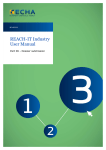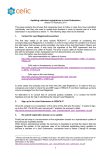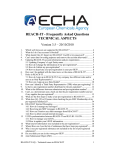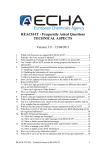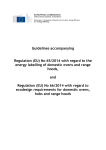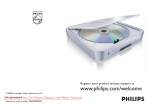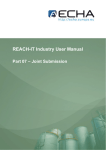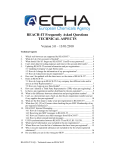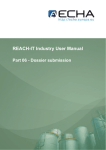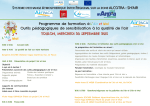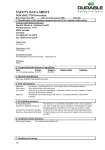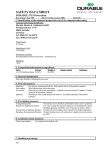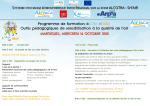Download CEFIC: Joint Submission Process in REACH
Transcript
REACH-IT News – Joint Submission Process JOINT SUBMISSION PROCESS in REACH-IT To be able to submit a dossier as Lead Registrant or member of a joint submission (JS), the lead registrant has first to create a JS object in REACH-IT. Afterwards, the member has to confirm his membership within this JS object prior to make dossier submission. For an extensive explanation of each step here after described, please refer to the ECHA Industry User Manuals1. 1 Link to the Regulation2 Manufacturers, importers or only representatives are individually obliged to submit a registration for each substance they are responsible for. In cases where a substance is manufactured or imported by more than one company, potential registrants are required to submit certain information together. This is called the joint submission (JS) of data. Joint submission may apply to a substance to be registered [REACH, article 11], as well as onsite or transported isolated intermediates [REACH, article 19]. Registrants are required to jointly submit information on the hazardous properties of the substance, its classification and labeling and testing proposal(s) (if any). It is also possible to jointly submit the chemical safety report and guidance on safe use (REACH, Article 11) if an agreement among the members is reached. The information that needs to be submitted jointly is provided only by the Lead registrant on behalf of the others. Each member of the joint submission shall submit separately and individually the following administrative information: - the legal entity identity, - the substance identity, - Information on the manufacture and on the use(s) of the substance including tonnage as well as some exposure information for substances registered in quantities of 1 to 10 tonnes. In terms of chronology, the lead registrant will have to submit first his registration dossier. Only when the joint submission dossier reaches the end of the process, the other registrants are allowed to submit their dossier. Therefore, when the lead registrant will receive the registration number of the joint submission registration, he is asked to inform all members (REACH-IT cannot be used for this) that his registration has been completed. 1 Part 6 – Dossier submission http://echa.europa.eu/doc/reachit/industry_user_manual/reachit_dossier_submission_en.pdf Part 7 – Joint Submission http://echa.europa.eu/doc/reachit/industry_user_manual/reachit_joint_submission_en.pdf 2 Source REACH-IT Industry User Manual – ECHA http://echa.europa.eu/doc/reachit/industry_user_manual/reachit_joint_submission_en.pdf Ariane BONTEMPS [email protected] 1 April 2009 REACH-IT News – Joint Submission Process A manufacturer or importer may decide to opt-out from some or all parts of the Joint registration dossier (opt-out of joint submission). Possible reasons for opting-out could be disproportional costs, the disclosure of information would be likely to lead to substantial commercial detriment, or disagreement with the lead registrant on the selection of the information submitted in the Joint Submission. A Member of a joint submission may also decide to opt-in for one or more confidentialities claimed by the lead in the Joint registration dossier. The opt-in has to be indicated in REACH-IT and the confidentiality claims should be indicated in his member dossier. 1.1 Lead and member registrants The company taking the role of the lead registrant has the responsibility to create the joint submission in REACH-IT, to submit the lead dossier and to manage the joint submission. The other companies, called member registrants, who want to be part of a joint submission, first have to confirm their membership to the joint submission in REACH-IT, before submitting their individual dossiers. In a joint submission, the lead registrant has to submit and get his dossier accepted first, before other SIEF members can submit their part of the dossier (see detail below). 1.2 The security token To ensure the unambiguous relation among the lead registrant and the member(s), a security token is created for each joint submission, and serves to the confirmation of membership by the members of a joint submission (see Lead Registrant process). When a potential member wants to confirm his membership, he has to enter the name of the joint submission and the security token, in REACH-IT. If the information is correct REACH-IT will display the joint submission information and will ask additional confirmation from the new joint submission member. Each security token has a limited validity of 30 days from its creation. If it expires, only the lead registrant can create a new security token (using REACH-IT) for the joint submission, upon request of a potential member. The lead registrant has to communicate with the potential new member(s) about the new security token outside REACH-IT. Ariane BONTEMPS [email protected] 2 April 2009 REACH-IT News – Joint Submission Process 2 STEP BY STEP explanation 2.1 STEP 1: Joint Submission object in REACH-IT Lead Registrant process 3 Following the ECHA key principles on SIEF , all SIEFs must select a Lead Registrant. REACH does not specify rules as to how the Lead Registrant should be selected. The Lead Registrant must act with the agreement of the other assenting registrants. The Lead Registrants preparing for the first registration deadline are advised to inform ECHA of their nomination. These nominations should be sent by e-mail to: [email protected] a. First step, the LR has to create a Joint Submission object via the Menu Joint Submission create Joint Submission Important note: This step has to be done prior to dossier submission. In the context of joint submission, the Lead Registrant can select the substance of the joint 4 submission by providing a Reference number type and a Reference number in the corresponding field: 3 See http://echa.europa.eu/doc/reachit/sief_key_principles.pdf 4 See ANNEX for information Ariane BONTEMPS [email protected] 3 April 2009 REACH-IT News – Joint Submission Process - Pre-registration number: one of the company’s pre-registered substances. Inquiry number: one of the company’s inquired substances. Registration number: one of the company’s already registered substances, including the Notified substances. If none of the above Reference numbers is applicable, the user can identify the substance via the same method as the one used for the pre-registration. First, the LR clicks on ‘add another constituent’ to identify the constituent(s) of the substance for which he is creating a JS. However, in that case, the user must provide an explanation as to why he did indicate neither a pre-registered / inquired substance, nor an already registered one. Ariane BONTEMPS [email protected] 4 April 2009 REACH-IT News – Joint Submission Process Finally, the LR specifies all constituents (if any) and clicks Continue when finished. b. The LR has to indicate the name of the Joint Submission (agreed among JS members) – so called below the ‘JS name’. This name will be used by all JS registrant (LR and members) The joint submission name must have between 8 and 30 characters. It is important to use well defined names for the JS, and not only rely on the substance identity. This JS name and the token (please see below for details) must be used by all members to confirm their membership. Technical note: The JS name is unique for the system – it’s impossible to have two identical JS names in REACH-IT. When the dossier is submitted in REACH-IT, the UUID (Universal Unique Identifier) of the Legal Entity and the substance ID are both checked against the information contained in REACH-IT. Ariane BONTEMPS [email protected] 5 April 2009 REACH-IT News – Joint Submission Process c. On behalf of Joint Submission, where needed and after agreement of JS members, the LR will indicate whether a Guidance on Safe use, CSR and a review by assessor will be provided. And add a new contact name or choose one (among contact names already created during the sign-up) to become responsible for Joint Submission follow-up for the LR. Ariane BONTEMPS [email protected] 6 April 2009 REACH-IT News – Joint Submission Process d. And finally the Lead Registrant validates the Joint Submission object. The Lead Registrant will get the TOKEN: a string of characters. The token has a limited validity of 30 days. The message for a confirmation of creation of a new Joint Submission goes to all the users of the Lead Registrant LE (so called the party in the message system of REACH-IT). The token and the JS name have to be provided to the members of the Joint Submission that fulfilled the agreement condition to receive the token. Important: The token and the JS name are the only ways for a member to confirm his membership within a specific joint submission. The LR has to provide a valid token (the LR can always re-create a token for this purpose, if the previous token has expired, as many as it’s needed). Ariane BONTEMPS [email protected] 7 April 2009 REACH-IT News – Joint Submission Process Member of a JS - process If the information was not yet available, a member of a JS has to contact the LR and ask for the JS name and the token. Using the token and the JS name, the member has to confirm his membership in the Joint Submission. The member will receive a confirmation of his successful submission of membership in his own REACH-IT message box. This confirmation is also sent to the Lead Registrant. Important note: Only a final registrant LE can be a member of a JS in REACH-IT. If a member is hidden behind a TPR: - The TPR will receive the token and the JS name from the lead Registrant. - The TPR has to bring back both data to its client. - The member must confirm himself his membership to the JS - The member will be ‘disclosed’ for the Lead Registrant ONLY. - The member must submit the substance dossier himself (see below for details on dossier submission) It’s important to notice that the list of Joint Submission members is filled up in REACH-IT. It is filled up by the JS members when they confirm their membership to the JS. Important note The Lead Registrant is the only one who can access to the list of all names of the JS members. The Lead Registrant can see all official LEs (even the ones previously hidden behind a TPR). The JS members can NOT see the list of members. The members can see the Lead Registrant by using the SEARCH module. Ariane BONTEMPS [email protected] 8 April 2009 REACH-IT News – Joint Submission Process STEP 2: Registration of a dossier The submission of a dossier to register a substance has to be made via the same REACH-IT process and module for any registrant (a Lead Registrant, a member of a joint submission, a ‘single’ registrant). Note: As explained above, the token is only mandatory for the JS member to confirm his membership to the JS. However, for the specific task of submitting a dossier itself, neither the LR nor the JS members will need the token. Important: The Lead Registrant has to submit the JS part and his own part of the dossier FIRST. Once the LR dossier registration is complete (Invoice is paid, TCC is successful and then the LR has received the registration number), other members of the JS can submit their specific dossier for the same substance, within the same joint submission and referring, where appropriate to the LR dossier. a. After login, the user opens the menu Registration/Notification. Ariane BONTEMPS [email protected] 9 April 2009 REACH-IT News – Joint Submission Process He chooses the right dossier type (see next screen shot). Important note: Within the Registration/Notification in REACH-IT, there is no possibility to choose ‘I would like to submit a joint submission dossier – as member or as LR. This specific ‘dossier type’ is NOT in the drop down list. Dossier types: drop-down list For any joint submission dossier (as a LR AND as a member), the chapter 1.5 in the IUCLID 5 dossier has to be correctly filled in. If not filled in, the dossier will NOT be considered as a joint submission dossier, and be either rejected (Member Submission) or considered to be a single registration. Ariane BONTEMPS [email protected] 10 April 2009 REACH-IT News – Joint Submission Process Technical note: REACH-IT will check the LE identity together with the substance identity (against what it has been put in the Joint Submission list – see above for details) to assess whether the registrant (member or Lead registrant) is known as a member of a JS. b. The user has to provide all necessary details to initiate the submission of a registration/ notification dossier. c. After clicking the ‘Proceed’ button, user can now browse his folders and select the file containing the dossier (file ‘.i5z’, made in IUCLID 5). And finally he presses ‘Submit dossier’ button to send the dossier. Ariane BONTEMPS [email protected] 11 April 2009 REACH-IT News – Joint Submission Process d. The user who submitted the dossier will receive a submission number in the internal message box of REACH-IT. Submission_Report_J Z121787-99.pdf 5 e. The invoice is then created by the Agency. Invoices are still sent to all users of the party . The Invoice Manager role, which is a contact name role, is only used by ECHA for personal communication. 5 For Party, User, Contact person and other technical definitions within REACH-IT, please refer to the Industry User Manual. Ariane BONTEMPS [email protected] 12 April 2009 REACH-IT News – Joint Submission Process Users can download the invoice (via the menu Registration/Notification view Registration/ Notification). In this menu, the user can see the Submission report and check the process followed by the dossier as well as the accounting details. And all users of the party (all users of the same LE which submitted the dossier) will receive a message when one of them has made the download of the invoice for the first time. Ariane BONTEMPS [email protected] 13 April 2009 REACH-IT News – Joint Submission Process f. After payment of the invoice and the success of the dossier TCC (technical completeness check), the registration number will be sent to the registrant through the internal REACH-IT mailbox (with the same date as the submission date). Important note: As a member of a JS, the user MUST wait for the completion of the registration by the Lead Registrant prior to be able to submit his own dossier (the optimal time is 21 days up to 2 months before the next registration deadline). If submitted before the completion of the registration by the Lead Registrant, his dossier will be rejected. The registration number issued by the system is the same for all JS members (except the 4 last digits). This ‘first part’ of the registration number (all digits but the last 4) as a reference can be used in order to communicate between LR and members to proof the completion of the LR registration. Ariane BONTEMPS [email protected] 14 April 2009 REACH-IT News – Joint Submission Process ANNEX Reference number - Extract of GUIDANCE on REGISTRATION – ECHA - http://reach.jrc.it/public2/getdoc.php?file=registration_en Once the registration is complete the REACH IT system at the Agency automatically assigns a registration number to the registrant for the substance concerned and a registration date that will be the same as the submission date. The Agency without delay communicates the registration number and date to the concerned registrant. From that moment on the registrant shall use the registration number for the subsequent correspondence regarding registration procedures (Articles 20 (3)). Moreover, the registration number will have to be incorporated in the SDSs for any supply after reception of that registration number. For a given substance, distinct dossier types may apply. For example, a substance initially notified as a PPORD may require the submission of a registration dossier at the end of the exemption period if the PPORD leads to a commercial use of the substance. Also, a substance for which initially a notification of the classification and labeling was submitted may later lead to the submission of a registration dossier. In those cases, the substance will hold an identification number of each kind, a PPORD number and a registration number in the first above example, and a C&L number and a registration number in the second above example All those numbers are called “Reference numbers” have the following structure: <TYPE>-<BASENUMBER>-<CHECKSUM>-<INDEX-NUMBER> where: <TYPE> is a 2-digit number giving the type of number: 01 Registration 02 C&L notification 03 Substance in article 04 PPORD 05 Pre-registration 06 Inquiries 07 On-site isolated intermediates* 08 Transported on-site isolated intermediates* 09 Data Holder notifications 10 Downstream User notifications 11 Applications for Authorisation 12 Substance Evaluations 13 Annex XV – C&L Harmonization 14 Annex XV – Authorisation 15 Annex XV – Restriction 16 Internal usage 17 Late Pre-registration: (reserved to pre-registrations According to REACH Regulation Article 28 (6)) <BASE-NUMBER> is a 10-digit number, <CHECKSUM> is a 2-digit number, <INDEX-NUMBER> is a 4-digit number giving the index of a member in a joint submission. * Type numbers 07 and 08 have been used for registration of intermediates but they are not used anymore. Instead, the type number ‘01’ is now used for all registration types. Important note: The Registration Number will be the same for all members and LR of the JS, except the 'index' part. Ariane BONTEMPS [email protected] 15 April 2009
















